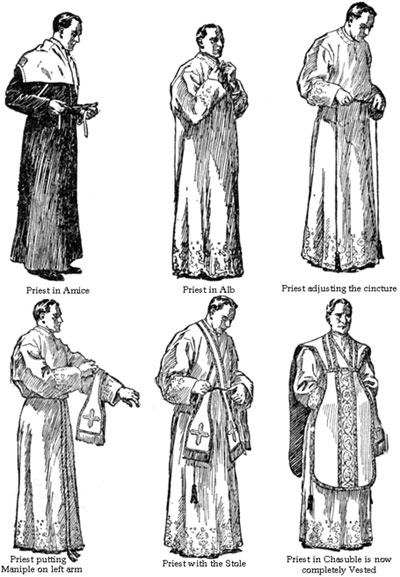The sacred vestments are visual expressions of the clergy's role in the Mass. For the priest, the vestments show him as "in persona Christi" ("in the person of Christ") during the liturgy.
Amice: A white linen cloth covering the neck and shoulder, recalling the cloth that the Roman soldiers used to blindfold Jesus while they beat him.
Alb: A long white linen robe, signifying innocence. It recalls the Transfiguration, when Jesus was clothed in garments white as the snow, as well as the white robe He was clothed in while Herod reviled Him.
Girdle/Cincture: A white cord that cinches the alb at the waist, symbolizing purity. The cord also recalls the rope that tied Jesus to the column as He was scourged.
Maniple: A length of cloth hung over the left arm, symbolizing several things: the chains that bound Jesus' hands, the burden of sin, the fatigue of priestly service. It developed from a handkerchief type cloth, which St. Alphonsus Liguori noted was often needed by priests to wipe away their tears during the celebration of the Mass.
Stole: A cloth hanging around the neck, crossing over the chest, recalling the rope tied around Jesus that led Him through the streets of Jerusalem to His crucifixion.
Chasuble: The outer robe, symbolizing the royal robe thrown over Jesus by the Roman soldiers as they mocked Him and crowned Him with thorns. It is ornamented with a column and cross design – recalling Jesus' scourging at the column and His crucifixion. When a priest prays as he vests, he speaks of the chasuble as the "yoke of Christ."
— Source: "The New Missal for Every Day," by Father Francis Xavier Lasance, 1949 edition




